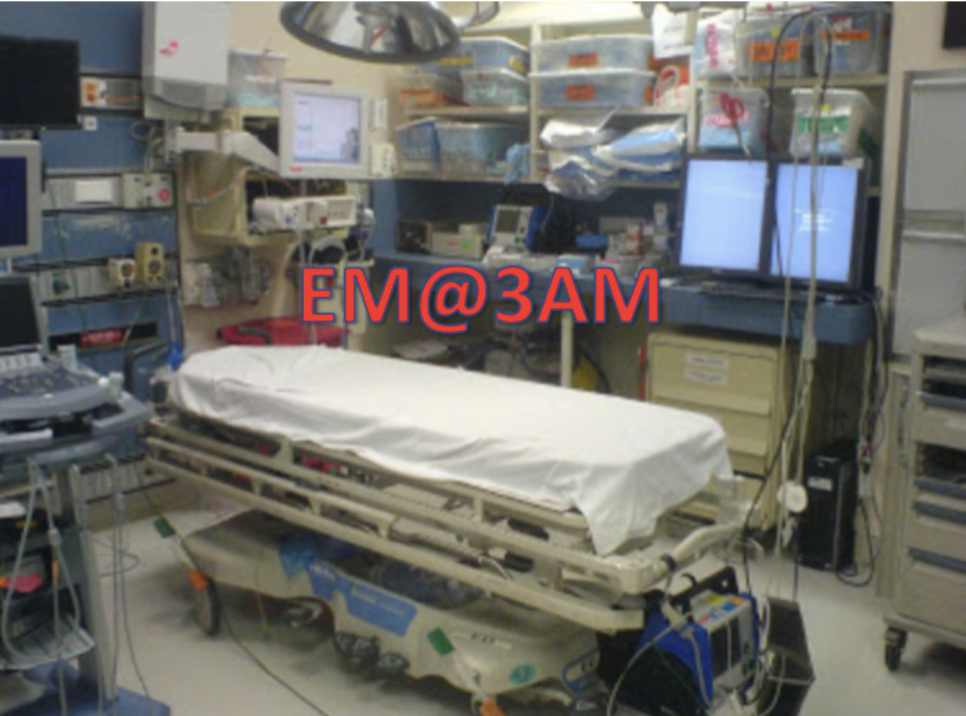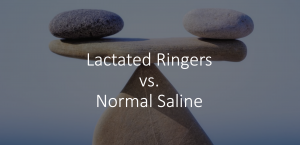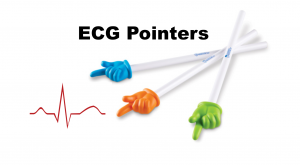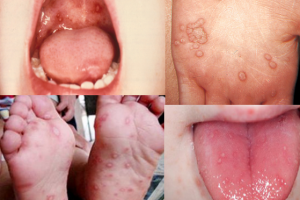Authors: Hailey VanRonzelen (MS-3, Kansas City University, RN-BSN); Jessica Pelletier, DO, MHPE (Assistant Professor of EM/Assistant Residency Director, Mizzou – Columbia, MO) // Reviewed by: Sophia Görgens, MD (EM Physician, BIDMC, MA); Cassandra Mackey, MD (Assistant Professor of Emergency Medicine, UMass Chan Medical School); Alex Koyfman, MD (@EMHighAK); Brit Long, MD (@long_brit)
A 53-year-old male with a past medical history of hyperlipidemia and cervical stenosis presents with dyspnea, which has been worsening since his cervical spinal fusion 6 days ago. He states he is very fatigued and feels as though he cannot get a deep breath.
Vital signs revealed a BP of 136/76, HR of 88, RR of 9, SpO2 of 94% on room air, and a temperature of 97.6 F. On physical exam, the patient is lethargic, has nasal flaring, and is using accessory muscles to breathe. Lung sounds are clear. On cardiac exam, there is normal rate and rhythm without murmur, rubs, or gallops. His capillary refill is 2 seconds. His surgical incision looks clean and without any signs of infection. An ABG is drawn and reveals pH of 7.53, pCO2 of 58, and PO2 of 83. Chest X-ray shows some mild atelectasis but no acute infiltrates.
What is the diagnosis?
Answer: Bradypnea
Background:
- Bradypnea is defined as a decreased respiratory rate and varies by age (Table 1)1
- Hypopnea is shallow breathing that occurs during sleep2

Etiology:
- Secondary to a number of causes. Most common:
- Cardiac
- Cheyne-Stokes respirations 2/2 congestive heart failure (CHF)5
- Congenital cardiac disease6
- Bradypnea can be seen after tachypnea as a sign of inevitable cardiopulmonary collapse and is a medical emergency1
- Agonal breathing: slow and irregular gasping breaths seen in a dying patient as an attempt to oxygenate7
- Endocrine/metabolic
- Environmental
- Hypothermia10
- Gastrointestinal (GI)
- Liver failure resulting in increased ammonia levels11
- Neurological
- Central sleep apnea12,13
- Cushing’s Reflex/Triad: bradycardia, bradypnea, hypertension seen in patients with increased intracranial pressure (ICP)14
- Neuromuscular disorders
- Tumor or stroke: Respiratory rate is controlled by the brainstem, nucleus tractus solitarius (NTS), and the nucleus ambiguus, which directly connect to the phrenic nerve18
- Psych
- Chronic stress and anxiety19
- Respiratory
- Toxicologic/pharmacologic
- Cardiac
Epidemiology:
- Incidence/prevalence
- Increased respiratory rate is more often seen in emergency settings and is an indicator of deterioration28
- A patient presenting with a decreased respiratory rate is more likely to die during emergency room admission29
- Opioid overdose is the most common cause of bradypnea in the ED30
Clinical Presentation:
- May present with hypoxia or hypercapnia
- These patients might have changes in mental status or decreased consciousness
- Cyanosis may be present
- Patients should be placed on continuous cardiac and pulse oximetry monitors
Evaluation:
- Arterial blood gas (ABG) in critically ill patients
- This will allow determination of oxygenation and ventilation status31
- PaO2 80-100 mmHg: shows appropriate oxygenation
- PaCO2 35-45 mmHg: shows adequate alveolar ventilation, removing CO2 from the bloodstream
- Note that venous blood gas (VBG) may not be as accurate for the assessment of PaO2 but is still useful for PaCO2 and is less painful32,33
- Metabolic alkalosis could cause the need to retain CO2, slowing the respiratory rate; exclude compensatory bradypnea secondary to GI losses, diuretic use, renal disorders33
- This will allow determination of oxygenation and ventilation status31
- Urine drug screen or blood alcohol level may reveal illicit substances, causing bradypnea
- Thyroid-stimulating hormone (TSH)8
- Evaluate for hypothyroidism
- T3, T4, and other thyroid hormones could show myxedema coma
- Chest x-ray
- Elevated hemidiaphragm (especially on the left, which is less common than the right) may suggest phrenic nerve damage
- Rule out pulmonology causes, such as COPD, pneumonia, etc.
- Assess for overt fractures or spinal cord compression
- MRI of head/cervical/thoracic/lumbar spine if concerns for spinal cord injury are present
- Electromyography/biopsy in the inpatient setting may be needed to more definitively rule out neuromuscular causes17
- Pulmonary function testing17
- Used in patients with suspected neuromuscular causes
- Negative inspiratory force (NIF) < -20 to -30 cmH2O OR forced vital capacity (FVC) < 10-20 mL/kg: the patient should be admitted to an intensive care unit in anticipation of the need for mechanical ventilation due to neuromuscular respiratory failure
Diagnosis:
- Requires a thorough history and physical exam
- Bradypnea will always be secondary to another cause
Treatment:
- Place on cardiac and pulse oximetry monitors and obtain IV access
- Respiratory support: oxygenation, noninvasive ventilation, mechanical ventilation
- Reversal of the underlying cause
![]()


CPAP = continuous positive pressure ventilation, CVA = cerebrovascular accident, BiPAP = bilevel positive pressure ventilation, CHF = congestive heart failure, CPR = cardiopulmonary resuscitation, GHB = gamma-hydroxybutyric acid, GI = gastrointestinal, HOB = head of bed, ICP = intracranial pressure, IVIG = intravenous immune globulin, LES = Lambert-Eaton myasthenic syndrome, LNW = last known well, LVO = large vessel occlusion. *Avoid if the patient uses benzodiazepines chronically, as precipitated withdrawal could cause seizures and death. **IV ethanol is an alternative in limited-resource settings or where fomepizole is not available.
Prognosis:
- Without other abnormal vital signs, respiratory rate alone is not indicative of the need for intensive care stays41
Pearls:
- Bradypnea is always caused by a secondary condition
- The differential diagnosis is broad
- Diagnostic workup should be tailored to the suspected underlying cause(s)
- Treatment involves reversal of the underlying cause


A 69-year-old man with a history of Alzheimer dementia presents to the ED with dyspnea. The patient’s caregivers noticed that the patient had become more short of breath over the last 12 hours and seemed confused. A chest radiograph is obtained, as seen above. Physical exam is notable for rales on auscultation and bilateral lower extremity pitting edema. Which of the following respiratory patterns would most likely be seen in this patient?
A) Biot respirations
B) Cheyne-Stokes respirations
C) Kussmaul respirations
D) Ondine respirations
Correct answer: B
This patient is presenting with congestive heart failure, given his pulmonary edema and bilateral lower extremity pitting edema, which are associated with Cheyne-Stokes respirations. Cheyne-Stokes respirations are characterized by episodes of apnea, followed by a gradual increase in respiratory frequency and tidal volume (i.e., hyperpnea), and then a decrease in frequency and tidal volume until the next period of apnea. Cheyne-Stokes respirations are commonly seen in cardiac disease and neurological disorders, including stroke, brain tumors, and brain injury. The pathophysiology is thought to be related to apnea, which causes an increased level of carbon dioxide and leads to excessive compensatory hyperventilation, in turn causing decreased levels of carbon dioxide, which causes apnea again. Often, Cheyne-Stokes respirations are a poor prognostic sign and a potential indicator of severe disease. Treatment involves treating the underlying cause. Patients in hospice with terminal illness presenting with Cheyne-Stokes respirations should receive comfort measures for symptom management.

Biot respirations (A) are associated with severe neuronal damage, in particular, when there is injury to the pons. It presents with quick and shallow breaths followed by episodes of apnea.
Kussmaul respirations (C) are a deep and rapid breathing pattern typically associated with metabolic acidosis, such as diabetes-related ketoacidosis. The increased ventilation decreases carbon dioxide levels, causing a respiratory alkalosis.
Ondine respirations (D) (the pathology is termed the Ondine curse) causes alveolar hypoventilation due to impaired autonomic control of ventilation. These patients will not adequately respire spontaneously. However, their volitional control of respiration is intact. This pattern of breathing can be seen in congenital hypoventilation syndrome, brainstem tumors, and surgical procedures in the cervical spinal cord.
Further Reading:
Further FOAMed:
- https://www.emdocs.net/em3am-overdose/
- https://www.emdocs.net/toxcard-cyanide-toxicity-and-treatment/
- https://www.emdocs.net/em3am-myxedema-coma/
- https://www.emdocs.net/pem-playbook-altered-mental-status-children/
References:
- Brady WJ, Mattu A, Slovis CM. Lay Responder Care for an Adult with Out-of-Hospital Cardiac Arrest. Jarcho JA, ed. N Engl J Med. 2019;381(23):2242-2251. doi:10.1056/NEJMra1802529
- Berry RB, Budhiraja R, Gottlieb DJ, et al. Rules for Scoring Respiratory Events in Sleep: Update of the 2007 AASM Manual for the Scoring of Sleep and Associated Events: Deliberations of the Sleep Apnea Definitions Task Force of the American Academy of Sleep Medicine. J Clin Sleep Med. 2012;08(05):597-619. doi:10.5664/jcsm.2172
- Fleming S, Thompson M, Stevens R, et al. Normal ranges of heart rate and respiratory rate in children from birth to 18 years of age: a systematic review of observational studies. The Lancet. 2011;377(9770):1011-1018. doi:10.1016/S0140-6736(10)62226-X
- Rückert-Eheberg IM, Steger A, Müller A, et al. Respiratory rate and its associations with disease and lifestyle factors in the general population – results from the KORA-FF4 study. Li, X, ed. PLOS ONE. 2025;20(3):e0318502. doi:10.1371/journal.pone.0318502
- Lorenzi-Filho G, Genta PR, Figueiredo AC, Inoue D. CHEYNE-STOKES RESPIRATION IN PATIENTS WITH CONGESTIVE HEART FAILURE: CAUSES AND CONSEQUENCES. Clinics. 2005;60(4):333-344. doi:10.1590/S1807-59322005000400012
- Saikia D, Mahanta B. Cardiovascular and respiratory physiology in children. Indian J Anaesth. 2019;63(9):690. doi:10.4103/ija.IJA_490_19
- Manole MD, Hickey RW. Preterminal gasping and effects on the cardiac function: Crit Care Med. 2006;34(Suppl):S438-S441. doi:10.1097/01.CCM.0000246010.88375.E4
- Wall CR. Myxedema coma: diagnosis and treatment. Am Fam Physician. 2000;62(11):2485-2490.
- Brown LK. Hypoventilation Syndromes. Clin Chest Med. 2010;31(2):249-270. doi:10.1016/j.ccm.2010.03.002
- American Heart Association. Part 10.4: Hypothermia. Circulation. 2005;112(24_supplement). doi:10.1161/CIRCULATIONAHA.105.166566
- Auron A, Brophy PD. Hyperammonemia in review: pathophysiology, diagnosis, and treatment. Pediatr Nephrol. 2012;27(2):207-222. doi:10.1007/s00467-011-1838-5
- Omran AM, Aboubakr SE, Aboussouan LS, Pierchala L, Badr MS. Posthypoxic ventilatory decline during NREM sleep: influence of sleep apnea. J Appl Physiol. 2004;96(6):2220-2225. doi:10.1152/japplphysiol.01120.2003
- San K, Wong E, Rosen C, Ahmed S, Chiang A. Profound Bradypnea in a Patient with Chronic Insomnia. Ann Am Thorac Soc. 2019;16(8):1062-1064. doi:10.1513/AnnalsATS.201902-184CC
- Fodstad H, Kelly PJ, Buchfelder M. HISTORY OF THE CUSHING REFLEX. Neurosurgery. 2006;59(5):1132-1137. doi:10.1227/01.NEU.0000245582.08532.7C
- Agrawal A, Timothy J, Cincu R, Agarwal T, Waghmare LB. Bradycardia in neurosurgery. Clin Neurol Neurosurg. 2008;110(4):321-327. doi:10.1016/j.clineuro.2008.01.013
- Yekzaman BR, Minchew HM, Alvarado A, Ohiorhenuan I. Phrenic Nerve Dysfunction Secondary to Cervical Neuroforaminal Stenosis: A Literature Review. World Neurosurg. 2022;167:74-77. doi:10.1016/j.wneu.2022.09.009
- Roper J, Fleming ME, Long B, Koyfman A. Myasthenia Gravis and Crisis: Evaluation and Management in the Emergency Department. J Emerg Med. 2017;53(6):843-853. doi:10.1016/j.jemermed.2017.06.009
- Russo MA, Santarelli DM, O’Rourke D. The physiological effects of slow breathing in the healthy human. Breathe. 2017;13(4):298-309. doi:10.1183/20734735.009817
- Brouillard C, Carrive P, Camus F, Bénoliel JJ, Similowski T, Sévoz-Couche C. Long-lasting bradypnea induced by repeated social defeat. Am J Physiol-Regul Integr Comp Physiol. 2016;311(2):R352-R364. doi:10.1152/ajpregu.00021.2016
- Rakshi K, Couriel JM. Management of acute bronchiolitis. Arch Dis Child. 1994;71(5):463-469. doi:10.1136/adc.71.5.463
- Schiller O, Levy I, Pollak U, Kadmon G, Nahum E, Schonfeld T. Central apnoeas in infants with bronchiolitis admitted to the paediatric intensive care unit. Acta Paediatr. 2011;100(2):216-219. doi:10.1111/j.1651-2227.2010.02004.x
- Shiota T, Kawanishi H, Inoue S, Egawa J, Kawaguchi M. Risk factors for bradypnea in a historical cohort of surgical patients receiving fentanyl-based intravenous analgesia. JA Clin Rep. 2018;4(1):46. doi:10.1186/s40981-018-0186-x
- Swift A, Wilson M. Reversal of the effects of clonidine using naloxone. Anaesth Rep. 2019;7(1):4-6. doi:10.1002/anr3.12004
- Henretig FM, Kirk MA, McKay CA. Hazardous Chemical Emergencies and Poisonings. Longo DL, ed. N Engl J Med. 2019;380(17):1638-1655. doi:10.1056/NEJMra1504690
- Tat J, Heskett K, Satomi S, Pilz RB, Golomb BA, Boss GR. Sodium azide poisoning: a narrative review. Clin Toxicol. 2021;59(8):683-697. doi:10.1080/15563650.2021.1906888
- Palmer JH, James S, Wadsworth D, Gordon CJ, Craft J. How registered nurses are measuring respiratory rates in adult acute care health settings: An integrative review. J Clin Nurs. 2023;32(15-16):4515-4527. doi:10.1111/jocn.16522
- Harry ML, Heger AMC, Woehrle TA, Kitch LA. Understanding Respiratory Rate Assessment by Emergency Nurses: A Health Care Improvement Project. J Emerg Nurs. 2020;46(4):488-496. doi:10.1016/j.jen.2020.03.012
- Hooker EA, O’Brien DJ, Danzl DF, Barefoot JAC, Brown JE. Respiratory rates in emergency department patients. J Emerg Med. 1989;7(2):129-132. doi:10.1016/0736-4679(89)90257-6
- Lunaesti C, Rahardja C, Firdaus R, Wijaya A. The Predictors of Mortality Among Critically Ill Patients in Emergency Department, Dr. Cipto Mangunkusumo Hospital. EJournal Kedokt Indones. 2014;2(3). Accessed April 2, 2025. https://www.neliti.com/publications/60160/the-predictors-of-mortality-among-critically-ill-patients-in-emergency-departmen
- Overdyk FJ, Carter R, Maddox RR, Callura J, Herrin AE, Henriquez C. Continuous Oximetry/Capnometry Monitoring Reveals Frequent Desaturation and Bradypnea During Patient-Controlled Analgesia. Anesth Analg. 2007;105(2):412-418. doi:10.1213/01.ane.0000269489.26048.63
- Yee J, Frinak S, Mohiuddin N, Uduman J. Fundamentals of Arterial Blood Gas Interpretation. Kidney360. 2022;3(8):1458-1466. doi:10.34067/KID.0008102021
- Wagner PD. The physiological basis of pulmonary gas exchange: implications for clinical interpretation of arterial blood gases. Eur Respir J. 2015;45(1):227-243. doi:10.1183/09031936.00039214
- Sanghavi SF, Swenson ER. Arterial Blood Gases and Acid–Base Regulation. Semin Respir Crit Care Med. 2023;44(05):612-626. doi:10.1055/s-0043-1770341
- Graudins A, Lee HM, Druda D. Calcium channel antagonist and beta-blocker overdose: antidotes and adjunct therapies. Br J Clin Pharmacol. 2016;81(3):453-461. doi:10.1111/bcp.12763
- An H, Godwin J. Flumazenil in benzodiazepine overdose. CMAJ Can Med Assoc J J Assoc Medicale Can. 2016;188(17-18):E537. doi:10.1503/cmaj.160357
- Lavonas EJ, Akpunonu PD, Arens AM, et al. 2023 American Heart Association Focused Update on the Management of Patients With Cardiac Arrest or Life-Threatening Toxicity Due to Poisoning: An Update to the American Heart Association Guidelines for Cardiopulmonary Resuscitation and Emergency Cardiovascular Care. Circulation. 2023;148(16). doi:10.1161/CIR.0000000000001161
- Scalley RD, Ferguson DR, Piccaro JC, Smart ML, Archie TE. Treatment of ethylene glycol poisoning. Am Fam Physician. 2002;66(5):807-812.
- Slaughter RJ, Mason RW, Beasley DMG, Vale JA, Schep LJ. Isopropanol poisoning. Clin Toxicol. 2014;52(5):470-478. doi:10.3109/15563650.2014.914527
- Haussmann R, Bauer M, Von Bonin S, Grof P, Lewitzka U. Treatment of lithium intoxication: facing the need for evidence. Int J Bipolar Disord. 2015;3(1):23. doi:10.1186/s40345-015-0040-2
- Kraut JA. Approach to the Treatment of Methanol Intoxication. Am J Kidney Dis. 2016;68(1):161-167. doi:10.1053/j.ajkd.2016.02.058
- Nates JL, Nunnally M, Kleinpell R, et al. ICU Admission, Discharge, and Triage Guidelines: A Framework to Enhance Clinical Operations, Development of Institutional Policies, and Further Research. Crit Care Med. 2016;44(8):1553-1602. doi:10.1097/CCM.0000000000001856






